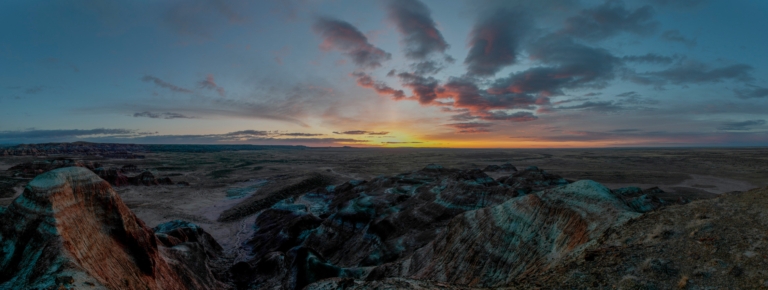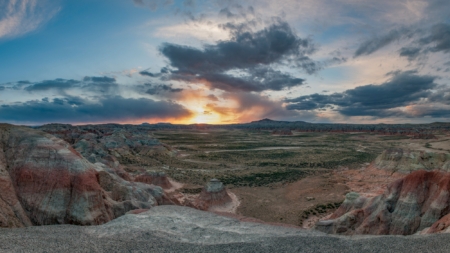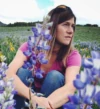Run the Red
A trail running race in southwest Wyoming brings attention to the importance of protecting the largest unfenced area in the contiguous United States.
The Red Desert is a place of harsh, wind-scoured beauty, a vast patchwork of public, state and private lands spread across the southwestern belly of Wyoming. The boundaries shift depending on who you’re talking to, but estimates put it around 6 million acres of mostly Bureau of Land Management (BLM) land. It’s defined by both pristine wildness and sporadic human development—roughly a dozen federally designated wilderness study areas sit like islands of preservation amid lands leased for energy and scarred by a long history of human use. Some call it the largest contiguous unfenced area in the United States. A paucity of information, few detailed maps and a rugged spiderweb of dirt roads makes it a difficult place to access. But for those who have ventured into the Red Desert, an abiding love typically forms.
“It just encapsulates that ruggedness and wildness that we think of when we think of Wyoming,” said Jonathan Williams, environmental stewardship coordinator at the National Outdoor Leadership School, which runs horse-packing trips in the area.
Evidence of human activity is ample; dirt roads cross the scrublands, oil pads dot sage territory—the BLM has leased hundreds of thousands of acres to energy development—and Interstate 80 bisects its southern section. But it also contains untrammeled beauty and geologic marvels, such as Adobe Town, a crumbled array of badlands and hoodoos; Steamboat Mountain, an old buffalo jump used by the Eastern Shoshone Tribe; and Oregon Buttes, twin flat-top mountains emigrant trains looked for as they crossed the plains. Recreationists horse-pack, hunt, hike, camp and learn about history throughout its sparsely beautiful expanses.
It’s red in some places—the product of ferruginous soil stained by iron oxide. And some zones could be described as desert. But the Red Desert also defies definition. It’s a place where rocky outcroppings fringed with aspen groves give way to otherworldly badlands. Where an isolated volcanic remnant erupts from a yawning complex of sand dunes, and where rare herds of desert elk roam across the sagebrush steppe.
On a grey day in September of 2019, with clouds sitting heavy overhead and a sleety mix falling, more than 200 people gathered in the ghost town of South Pass City, about an hour south of Lander and the granite turrets of the Wind River range. The town, once a thriving mining hub and territorial capital home to more than 20 saloons, sits at 7,440 feet on the northern boundary of the Red Desert, among aspens that on this day were ablaze in gold.
A hardy crowd of runners and land advocates from Wyoming’s small but scrappy conservation organizations were in South Pass for the sixth annual Run the Red race. The event was created in 2014, on the 50th anniversary of the Wilderness Act, to spur access, admiration and ultimately advocacy for a remote and off-the-beaten-path Wyoming desert that advocates say needs all the allies it can get.
“Run the Red [was] really birthed from this idea: how can we build an activity or showcase this place in a way that allows people to experience it the way wilderness should be experienced,” said Shaleas Harrison, a longtime wildlands community organizer, who was instrumental in creating the event. “And running is one of those activities.”

Looking north at the Honeycomb Buttes Wilderness Study Area, Continental Peak and the southern Wind River Range. The sage steppe in the foreground is often inhabited by wild horses, elk or pronghorn antelope. Photo: Scott Copeland
But Wyoming is an energy state. The state, which sits atop rich fossil fuel reserves left by ancient sea beds, is one of America’s leading energy producers, with a robust output of coal, oil and gas that before the COVID-19 crisis had only increased since the post-9/11 Bush administration push for energy independence. It produces 15 times more energy than it consumes, making it the biggest net energy supplier in the country.
A new White House push for energy dominance—this time from Donald Trump—has many worried anew for the fate of the Red Desert, where developers have already drilled thousands of oil and gas wells.
This isn’t the first time the Red Desert has been at the center of a conservation battle. More than 100 years ago in 1898, a hunter from Lander mounted an unsuccessful campaign to get the region designated as a winter game preserve. A 1935 attempt to create a national park by then governor Leslie Miller also failed, as did further attempts at protection by Wyoming Outdoor Council founder Tom Bell in the 1960s.
Along with the losses, there were conservation successes. In the 1990s, following a years-long process of inventory, study and public comment, roughly 12 areas of significance were designated as Wilderness Study Areas, a status whereby they are managed for their wilderness qualities and protected from activities like road-building and energy development, much like designated wilderness.
These include 10 in the zone known as the Northern Red Desert—the largest concentration in the state, according to Julia Stuble, Wyoming public lands and energy associate for the Wilderness Society.
Only an act of Congress can create or release WSAs, so they are considered fairly safe. But proposals occasionally arise that cast doubt on their fate—such as an effort by county commissioners to reclassify them in order to manage some for multiple use, or a bill brought by U.S. Rep. Liz Cheney (R-Wyo) that would have lifted many designations. Though those efforts failed, Harrison said, it seems the WSAs “are becoming more and more threatened by potential legislation.”
Another conservation success, Stuble said, is that under BLM management, several other significant zones—such as the Jack Morrow Hills—have been deemed incompatible for energy development and are under administrative protections or other stipulations.
“What it’s resulted in is a lot of protections for the area,” Stuble said of the northern Red Desert zone. If you couple those strong limitations on leasing with plummeting natural gas prices, she said, the area could well be left alone.
But—and it’s a big but—the Bureau of Land Management is in the process of revising its Rock Springs Resource Management Plan, a voluminous and technical document that steers management of 3.5 million acres of the Red Desert. Considering the Trump administration’s “energy dominance” agenda—which urges expanded domestic energy production—many worry the plan will open up leasing in areas that are currently shielded and increase leasing in other areas where it is currently limited.
“There can be a number of pretty significant ways to undo some of that protection, and we’re concerned about that,” said John Burrows, a conservation advocate with the Wyoming Outdoor Council.
While the WSAs will likely remain protected, according to Stuble, it’s the fate of the lands in between those islands of wildness that is troubling. “The connectivity of the landscape is what’s at risk,” she said. “Even though all the WSAs won’t change, all the connecting lands between them would.”
Advocates for protecting the Red Desert say its very nature as a relatively unknown and difficult-to-access destination can result in the landscape being overlooked by the conservation community, while energy development slowly infringes.
“This is a landscape where I think that the challenge is death by a thousand cuts,” said John Burrows, a conservation advocate with the Wyoming Outdoor Council. “It’s a long-term cumulative challenge, and in some ways that’s a harder issue to rally around.”

Mid-April in the Red Desert is cold and it’s too early for the spring green-up. Photo: Scott Copeland
It’s this very lack of awareness that spurred a grassroots group of conservationists to launch Run the Red. The event, which sends ultra-, full- and half-marathon runners through the Red Desert’s rocky outcropping and sage scrub, is dedicated to raising awareness about, introducing people to and ultimately protecting the Red Desert.
Despite foul weather that forced last-minute rerouting, organizers considered it the best race so far. Ultrarunners endured cold precipitation on the 56-mile route, others opted for marathon or half-marathon lengths, and at the end of the event, a crowd gathered to celebrate the landscape with talks, music and advocacy. Several participants scribbled their thoughts on postcards that were sent to Wyoming governor Mark Gordon.
“Encouraging runners to be part of advocacy was a really big deal this year,” said race organizer and ultrarunner Gabe Joyes. “It became so much more than a race, it truly was a race for open spaces.”
Professional ultrarunner Clare Gallagher made the drive from Colorado to run. She wasn’t too familiar with the Red Desert, she said, but there’s nothing like running mile by mile across a landscape to get to know it.
“It made me feel really connected to the Red Desert in a way that I’ll always remember,” Gallagher said. “It’s a very hidden and unknown public lands gem which I think has tremendous value.”
The diverse crowd—conservationists, musicians, runners, families, politicians and Native Americans with ties to the land—was telling, said Gallagher.
Jason Baldes, a member of the Eastern Shoshone Tribe who works for the National Wildlife Federation Tribal Partnerships program, was one of the speakers. Baldes spent much of his childhood venturing into the Red Desert with his father—a biologist and amateur geologist—to camp, ride horses and explore ancestral sights.
The Red Desert, he pointed out, was part of the original Fort Bridger Treaty of 1863, which gave the Shoshone Indians more than 40 million acres of lands as part of a US attempt to ensure safe passage of white emigrants. When that treaty was revised, the tribes lost most of the land, including the Red Desert. But it remains for them a place of deep significance—where ancient chippings, campsites and buffalo jumps mark centuries of use by the Eastern Shoshone.
“There’s lots of reasons to want to be involved with protecting the Red Desert,” Baldes said. “For me it’s more about the historic and cultural ties we have to the land.”
The Red Desert isn’t for everyone. The wind howls, the sun bakes, the land stretches out in shades of dun and beige. “It’s just so big and empty and diverse,” Joyes said. “And it’s one of those places that takes a bit of a critical eye or slowing down to appreciate it.”
But for those who have braved the bumpy roads, tried to decipher its petroglyphs or ventured into the moonscape of pillars and cliffs at Adobe Town, the Red Desert often becomes a beloved place, and one worth fighting for. An act of conservation, after all, often begins with just knowing what’s there.
“This is just an amazingly unique Wyoming—really emphasizing Wyoming—landscape,” Burrows said. “You are talking about stark, vast views without development for the most part, crystal-clear beautiful night skies. The wind in your face, the high sage. There’s kind of a power to the landscape.”
“This is a place that looks the same as it did 500 years ago,” Harrison said. “How many places can you go where you can say that?”
Though evidence of human activity is widespread, Harrison said she and other advocates want to maintain the untouched qualities of those pockets of excruciating beauty and pure wildness that do exist in the Red Desert.
Run the Red doesn’t aim to be a marquee event on the running circuit. Its goal is about introducing people to the landscape step by windy step, proving that the Red Desert has values that go far beyond the extractive, and illuminating what’s at stake.
“I don’t know if it’ll ever be a big competitive race, and that’s not what we’re going for,” Joyes said. “The whole goal is to celebrate the land.”
Run the Red 2020 has been cancelled, but you can learn more about the race and plan for 2021 at the Wyoming Wilderness Association’s race page.
Keep the Red Desert Wild!
Write to Governor Mark Gordon and tell him how much you value this special place, and urge him to keep the Red Desert wild for future generations.

